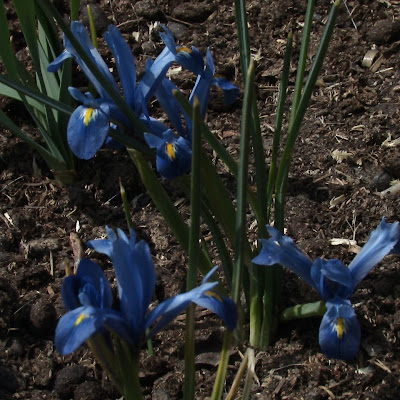I hope we don't have to bottle feed this year. It's always so much better when the mothers can take care of everything on their own. We have had to do it many times in the past, though. Most often, it's when a set of triplets is born, and one of them is consistently left out. The two bigger babes will rush together up to their mother and nurse greedily until she's tired of them and moves away. The little one goes hungry. Sometimes, the mother will refuse to accept a kid, though this hasn't happened to us much. The most devastating is when the mother dies in birthing. Thankfully, this is rare, but it's one of the things a farmer has to face, especially when living hours away from a vet.
Bottle feeding is fun, but terribly time-consuming. Our first experience was with five kids (see my posts of January 19 and 23, 2011). The next year, we had a different situation that modified our ideas considerably:
Sally had twins in 1993. She gave birth easily and the kids were healthy and strong. She had lots of milk, but her udder was so pendulous that the teats hung just inches from the ground. The kids found the udder, but they kept standing under it, nuzzling upwards, trying to find teats above them where they expected them to be. When they became frustrated and discouraged, we helped them by forcing them to kneel and putting the teats into their mouths. The little doeling (Celeste), caught on fast. After we'd helped her two or three times, she learned to nurse on her own. The buckling, however, seemed a bit dim. He just couldn't get the hang of it and could only nurse when we helped him.
Our books said that we should bottle feed five times a day, so five times a day, we'd go out and help our little dimwit find the teat. Each time we went out, he would be looking hollow-sided and hungry, and we'd leave him happy and with a nice round tummy. Celeste, however, always looked the same shape and always seemed satisfied. By the end of a week, the difference in their growth was obvious. Celeste was much bigger. We increased the frequency of feedings for the buckling to six per day, but Celeste continued to gain on him. This went on for two or three weeks, till he finally got it figured out and nursed on his own. Then, his growth caught up with hers.
Since that time, whenever we need to bottle feed, we do it much more often. (The total amount of milk per day doesn't change, we just divide it into more feedings.) When I go out to spend a few hours with the herd, I take a clean bottle. I catch a goat, milk her into the bottle, then tuck it inside my shirt, against my skin to keep it warm. Whenever I see the other kids nursing, I'll let my bottle baby have a sip. After the kids have begun to eat grain and grass, it becomes less important to give lots of feedings, and we thankfully switch back to three or four times a day.
I know that it's quite possible to raise healthy kids without going to so much trouble. However, I like to do my best for them, to give them the closest approximation to a natural life that I can. In the case of a dead mother, or one who has rejected them, I also give them as much cuddling as possible. As my absolute favourite goat-keeping book states:
"emotional deprivation in youth does not make for emotional stability in adult life in man or beast." - Goat Husbandry, David Mackenzie



























